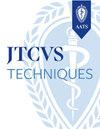Current intraoperative mechanical circulatory support strategies for bilateral lung transplantation surgery
IF 1.9
Q3 CARDIAC & CARDIOVASCULAR SYSTEMS
引用次数: 0
Abstract
Objective
To discuss technical strategies and considerations to facilitate intraoperative extracorporeal membrane oxygenation (ECMO) management during lung transplantation.
Methods
We review our institutional approach to the management of intraoperative ECMO during bilateral lung transplantation. Our proposed algorithm summarizes technical considerations based on the mechanical circulatory support (MCS) platform encountered in the operating room.
Results
For patients without preoperative ECMO, an assessment of indications and available configurations in anticipation of the need for intraoperative ECMO is required. Our initial MCS approach for isolated respiratory failure is venovenous (VV) ECMO. If patients have pulmonary hypertension or right ventricular dysfunction with acceptable vascular access, then peripheral venoarterial (VA) ECMO is attempted. However, we maintain a low threshold for conversion to central aortic cannulation with a modified Seldinger technique through a clamshell or bilateral anterior thoracotomy incision. For patients bridged to lung transplantation on VV ECMO or venopulmonary (VPa) ECMO, our initial approach is to reverse flow through existing venous cannulas when possible and provide outflow through central aortic cannulation. Finally, for patients bridged to lung transplantation on peripheral VA ECMO, conversion to a central VA ECMO platform is preferred in the setting of poor flow or central hypoxemia. Importantly, all patients at our institution requiring MCS during lung transplantation are supported on a modified circuit that allows for rapid conversion from VA ECMO to full cardiopulmonary bypass (CPB) as needed.
Conclusions
We propose a simple and technically feasible algorithm to facilitate the intraoperative conversion of VV, VPa, and VA ECMO patients to a modified central VA ECMO/CPB platform during bilateral lung transplantation.
当前双侧肺移植手术术中机械循环支持策略
目的探讨肺移植术中体外膜氧合(ECMO)管理的技术策略和注意事项。方法回顾我国双侧肺移植术中ECMO的处理方法。我们提出的算法总结了基于手术室中遇到的机械循环支持(MCS)平台的技术考虑。结果对于术前未进行ECMO的患者,需要评估术中ECMO的适应症和可用配置。我们对孤立性呼吸衰竭的初始MCS方法是静脉-静脉(VV) ECMO。如果患者有肺动脉高压或右心室功能障碍,血管通路可接受,则尝试外周静脉动脉(VA) ECMO。然而,我们通过翻盖或双侧前开胸切口采用改良的Seldinger技术转换为中央主动脉插管的门槛很低。对于通过VV ECMO或VPa ECMO进行肺移植的患者,我们最初的方法是尽可能逆转现有静脉插管的血流,并通过中央主动脉插管提供流出。最后,对于在外周VA ECMO上进行肺移植的患者,在血流差或中枢性低氧血症的情况下,首选转换到中央VA ECMO平台。重要的是,我们机构在肺移植期间需要MCS的所有患者都支持改良电路,该电路允许根据需要从VA ECMO快速转换为全体外循环(CPB)。结论我们提出了一种简单且技术可行的算法,可促进双侧肺移植过程中VV、VPa和VA ECMO患者术中转换到改良的中央VA ECMO/CPB平台。
本文章由计算机程序翻译,如有差异,请以英文原文为准。
求助全文
约1分钟内获得全文
求助全文

 求助内容:
求助内容: 应助结果提醒方式:
应助结果提醒方式:


